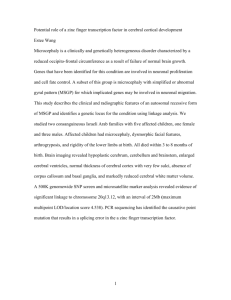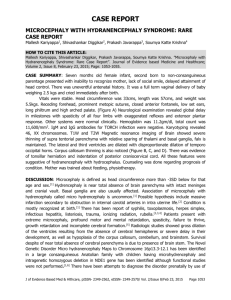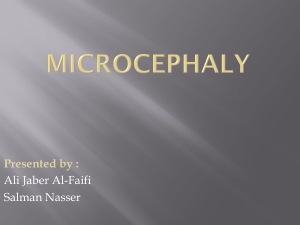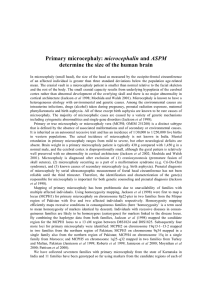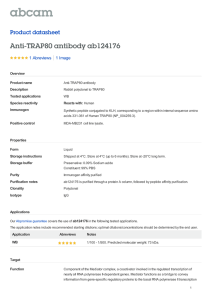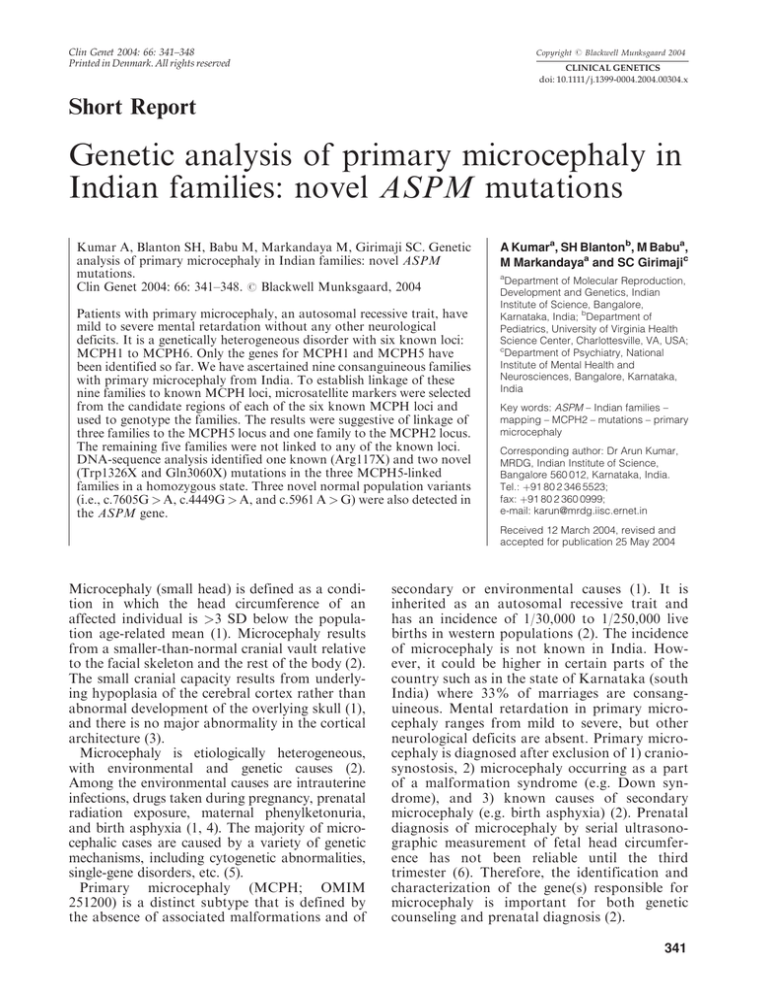
Clin Genet 2004: 66: 341–348
Printed in Denmark. All rights reserved
Copyright # Blackwell Munksgaard 2004
CLINICAL GENETICS
doi: 10.1111/j.1399-0004.2004.00304.x
Short Report
Genetic analysis of primary microcephaly in
Indian families: novel ASPM mutations
Kumar A, Blanton SH, Babu M, Markandaya M, Girimaji SC. Genetic
analysis of primary microcephaly in Indian families: novel ASPM
mutations.
Clin Genet 2004: 66: 341–348. # Blackwell Munksgaard, 2004
Patients with primary microcephaly, an autosomal recessive trait, have
mild to severe mental retardation without any other neurological
deficits. It is a genetically heterogeneous disorder with six known loci:
MCPH1 to MCPH6. Only the genes for MCPH1 and MCPH5 have
been identified so far. We have ascertained nine consanguineous families
with primary microcephaly from India. To establish linkage of these
nine families to known MCPH loci, microsatellite markers were selected
from the candidate regions of each of the six known MCPH loci and
used to genotype the families. The results were suggestive of linkage of
three families to the MCPH5 locus and one family to the MCPH2 locus.
The remaining five families were not linked to any of the known loci.
DNA-sequence analysis identified one known (Arg117X) and two novel
(Trp1326X and Gln3060X) mutations in the three MCPH5-linked
families in a homozygous state. Three novel normal population variants
(i.e., c.7605G > A, c.4449G > A, and c.5961 A > G) were also detected in
the ASPM gene.
A Kumara, SH Blantonb, M Babua,
M Markandayaa and SC Girimajic
a
Department of Molecular Reproduction,
Development and Genetics, Indian
Institute of Science, Bangalore,
Karnataka, India; bDepartment of
Pediatrics, University of Virginia Health
Science Center, Charlottesville, VA, USA;
c
Department of Psychiatry, National
Institute of Mental Health and
Neurosciences, Bangalore, Karnataka,
India
Key words: ASPM – Indian families –
mapping – MCPH2 – mutations – primary
microcephaly
Corresponding author: Dr Arun Kumar,
MRDG, Indian Institute of Science,
Bangalore 560 012, Karnataka, India.
Tel.: þ91 80 2 346 5523;
fax: þ91 80 2 360 0999;
e-mail: karun@mrdg.iisc.ernet.in
Received 12 March 2004, revised and
accepted for publication 25 May 2004
Microcephaly (small head) is defined as a condition in which the head circumference of an
affected individual is >3 SD below the population age-related mean (1). Microcephaly results
from a smaller-than-normal cranial vault relative
to the facial skeleton and the rest of the body (2).
The small cranial capacity results from underlying hypoplasia of the cerebral cortex rather than
abnormal development of the overlying skull (1),
and there is no major abnormality in the cortical
architecture (3).
Microcephaly is etiologically heterogeneous,
with environmental and genetic causes (2).
Among the environmental causes are intrauterine
infections, drugs taken during pregnancy, prenatal
radiation exposure, maternal phenylketonuria,
and birth asphyxia (1, 4). The majority of microcephalic cases are caused by a variety of genetic
mechanisms, including cytogenetic abnormalities,
single-gene disorders, etc. (5).
Primary microcephaly (MCPH; OMIM
251200) is a distinct subtype that is defined by
the absence of associated malformations and of
secondary or environmental causes (1). It is
inherited as an autosomal recessive trait and
has an incidence of 1/30,000 to 1/250,000 live
births in western populations (2). The incidence
of microcephaly is not known in India. However, it could be higher in certain parts of the
country such as in the state of Karnataka (south
India) where 33% of marriages are consanguineous. Mental retardation in primary microcephaly ranges from mild to severe, but other
neurological deficits are absent. Primary microcephaly is diagnosed after exclusion of 1) craniosynostosis, 2) microcephaly occurring as a part
of a malformation syndrome (e.g. Down syndrome), and 3) known causes of secondary
microcephaly (e.g. birth asphyxia) (2). Prenatal
diagnosis of microcephaly by serial ultrasonographic measurement of fetal head circumference has not been reliable until the third
trimester (6). Therefore, the identification and
characterization of the gene(s) responsible for
microcephaly is important for both genetic
counseling and prenatal diagnosis (2).
341
Kumar et al.
Mapping of primary microcephaly has been
problematic due to unavailability of families
with multiple affected individuals. However,
some progress has been made recently with the
mapping of six loci using relatively large families:
MCPH1 on chromosome 8p22-pter mapped in
two families from Mirpur region of Pakistan (2);
MCPH2 on chromosome 19q13.1–13.2 mapped
in two families from northern region of Pakistan
(7); MCPH3 on chromosome 9q34 mapped in a
single family from northern region of Pakistan
(8); MCPH4 on chromosome 15q in a single
family from Morocco (9); MCPH5 on chromosome 1q25–q32 mapped in two families from
Turkey (10) and Multan, Pakistan (11); and
MCPH6 on chromosome 13q12.2 in a single
family from Brazil (12). Recently, the genes for
the MCPH1 and MCPH5 loci have been isolated
(13, 14). The microcephalin gene mutated in the
MCPH1 families contains 14 exons and codes for
an 835 amino-acid-long protein (13). The microcephalin protein contains three BRCT domains
and is expressed in a wide variety of tissues
including brain, kidneys, heart, lungs, etc. (13).
The ASPM gene (MCPH5) contains 28 exons with
a 10,434 bp long open reading frame (ORF) that
codes for a 3477 amino-acid-long protein (14). The
ASPM protein is predicted to contain an amino
terminal microtubuline-binding domain, a calponin-homology domain, 74 isoleucine-glutamine
(IQ) domains, and a C-terminal region (14). The
ASPM gene is expressed in fetal brain (14). The
ASPM protein is conserved in human, mouse,
Drosophila, and Caenorhabditis elegans with a consistent correlation of brain complexity and protein
length, principally involving an increase in the
number of encoded IQ domains (14). Jackson
et al. (13) have reported a common mutation,
S25X in two MCPH1 families from northern
Pakistan. A total of 22 protein truncating mutations have been reported in the ASPM gene so far
in patients from Pakistan, Turkey, Yemen, Saudi
Arabia, Jordan, and the Netherlands (14, 15).
However, no study has been carried out to evaluate the genetics of primary microcephaly in the
Indian population. We report here the results
of genetic analysis of primary microcephaly in
nine consanguineous families from the state of
Karnataka, south India for the first time.
Materials and methods
Subjects
We have ascertained nine families with primary
microcephaly from the state of Karnataka, south
India. The number of affected individuals in these
342
families ranged from one to three. Consanguinity
was observed in all families. According to clinical
histories, microcephaly was present at birth, and
there was no history of neurological deficits or
other problems in the affected individuals. On
examination, the head circumferences of the
affected individuals were 8–13 SD below the
population age-related mean. Except for the
microcephaly, there were no dysmorphic features
in affected individuals. Figure 1 shows photographs of microcephaly patients. All parents
appeared to have normal intelligence and normal
head circumferences. The Social Quotient (SQ) of
affected individuals was measured by Indian
adaptation of Vineland Social Maturity Scale by
one of us (SCG) (16, 17). No maternal or environmental causes of microcephaly were identified
in these families. Informed consent was obtained
for research following the approval of the institute’s ethical committee.
Chromosome analysis and genotyping
In order to exclude the possibility of chromosome
aberrations as the cause of microcephaly in these
families, high-resolution G-banding chromosomal analysis of one affected individual from
each family was carried out as described in
Kumar et al. (18). For genotyping, total genomic
DNA samples were extracted from peripheral
blood samples using a WizardTM Genomic
DNA Purification kit (Promega Inc., Madison,
WI). In order to determine whether these families
were linked to one of the six known MCPH loci,
we selected a minimum of three microsatellite
markers from each of the candidate regions of
these loci and genotyped all available individuals
from these nine families (2, 7–12). Microsatellite
markers used for genotyping were: D8S1798,
D8S277, D8S1819, and D8S1825 for the
MCPH1 locus; D19S226, D19S416, D19S245,
D19S425, D19S224, D19S570, D19S881,
D19S400, D19S420, and D19S418 for the
(a)
(b)
(c)
Fig. 1. Photographs of microcephaly patients. (a) Individual V-1
from family 4, (b) Individual V-2 from family 4, and (c)
individual IV-2 from family 5 (for pedigrees see Fig. 2).
Primary microcephaly in Indian patients
MCPH2 locus; D9S1872, D9S1682, D9S1881, and
D9S1821 for the MCPH3 locus; D15S222,
D15S659, D15S962, and D15S98 for the MCPH4
locus; D1S2757, D1S2816, D1S1660, D1S2622,
D1S373, D1S1181, D1S1723, D1S2655, and
D1S1678 for the MCPH5 locus; and D13S787,
D13S1304, and D13S221 for the MCPH6 locus.
Microsatellite markers were purchased from
Research Genetics Inc. (Huntsville, AL) or were
synthesized commercially according to data from
the Genome Database (http://www.gdb.org/).
Marker order was obtained from deCode genetic
map (19). Genetic distances were obtained from
the Marshfield Medical Research Foundation
web site (http://www.research.marshfieldclinic.org/
genetics/). For those markers whose order could
not be resolved on the genetic linkage map, the
order was established using the sequence map
from the UCSC Genome Bioinformatics site
(http://www.genome.ucsc.edu/). Physical distances
between markers were obtained from the UCSC
Genomics Bioinformatics Site. Amplification of
microsatellite markers was performed as reported
by Kumar et al. (18). Radiolabeled polymerase
chain reaction (PCR) products were separated on
6% denaturing polyacrylamide-sequencing gels
and were either subjected to Phosphor Image
analysis or exposed to X-ray films.
DNA-sequence analysis of the ASPM gene
In order to determine the mutations in the ASPM
gene in MCPH5-linked families, a set of 41 PCR
primers, which cover the entire 10,434-bp long
ORF of this gene along with intron/exon junction, were made. These primers are available on
request from the first author. Mutations in the
ASPM gene were detected by sequencing the
PCR products from one affected individual
from each of MCPH5-linked families on an
ABIprism A310-automated sequencer (PE Biosystems, Foster City, CA). Once a mutation was
detected in an affected individual from a family,
the rest of the family members were tested for the
Family 4
I- 1
Family 5
I-2
I-1
II-1
III-1
D1S2757
D1S2816
D1S1660
D1S2622
D1S373
D1S1181
D1S1723
D1S2655
D1S1678
(a)
II-2
II-3
III-2
III-3
IV-2
2
2
4
5
3
3
3
7
3
2
2
4
5
3
3
3
7
3
4
1
4
2
2
4
3
9
4
V-2
22
22
44
55
33
33
33
77
33
22
22
44
55
33
33
33
77
33
V-3
4
1
4
2
2
4
3
9
4
2
2
4
5
3
3
3
7
3
II-1
III-4
IV-1
V-1
I-2
II-4
3
3
3
5
3
5
3
5
2
III-1
III-2
D1S2757
D1S2816
D1S1660
D1S2622
D1S373
D1S1181
D1S1723
D1S2655
D1S1678
II-2
II-3
II-4 II-5
III-3
III-4
5
2
4
6
6
3
1
8
5
5
2
4
6
6
3
1
8
5
2
1
2
3
4
8
3
6
3
V-5
IV-1
IV-2
2
2
4
5
3
3
3
7
3
2
2
4
5
3
3
3
7
3
5
2
4
6
6
3
1
8
5
55
22
44
66
66
33
11
88
55
3
3
3
5
3
5
3
5
2
2
1
2
3
4
8
3
6
3
III-6
4
3
4
4
1
4
4
7
2
V-4
3
3
3
5
3
5
3
5
2
III-5
II-6
(b)
Fig. 2. Haplotype analysis of (a) family 4 and (b) family 5 with MCPH5 markers. Disease haplotype is boxed.
343
Kumar et al.
of 1/300 (2). Population-specific allele frequencies
are not available for the Indian population; therefore, equal marker allele frequencies were
assumed for linkage analysis. Varying the allele
frequencies did not substantially change the linkage results. Multipoint linkage analysis was conducted using Genehunter2 (24).
presence of the mutation by DNA-sequence analysis. Allele-specific oligonucleotide hybridization
(ASOH) was used to determine if a mutation was
present in 50 ethnically matched normal individuals as described by Cormand et al. (20).
Linkage analysis
Because all the nine families were consanguineous, identity by descent was sought and used to
assess evidence of linkage to a particular locus
(21, 22). Linkage of consanguineous families to
a locus is based on the observation that if all
affected individuals of a family had the same
homozygous haplotype for a MCPH locus, the
family was designated linked; if the affected individuals had different heterozygous marker results
or different homozygous haplotypes, the family
was considered as not linked (22). Two-point lod
scores were calculated using the MLINK program
from the LINKAGE Package version 5.1 (23),
under the assumption of autosomal recessive
mode of inheritance and a disease-gene frequency
II-1
Results
High-resolution G-banding chromosome analysis
revealed normal karyotypes in patients from all
nine families (data not shown). Haplotype analysis using markers from six known MCPH loci
suggested linkage of three families, family 4,
family 5, and family 12 to the MCPH5 locus
only (Figs 2 and 3a). Haplotype analysis of family
2 was suggestive of linkage of this family to the
MCPH2 locus only (Fig. 3b). The remaining five
families were not linked to any of the six known
loci (data not shown). Affected individuals
from family 4, family 5, and family 12 were
Family 12
Family 2
I-1
I-1
I-2
II-2
III-1
II-3
III-2
II-4
II-1
I-2
II-2
II-3
III-3
IV-1
D1S 2757
D1S 2816
D1S 1660
D1S 2622
D1S 373
D1S 1181
D1S 1723
D1S 2655
D1S 1678
3
3
1
3
5
2
1
1
2
6
3
4
10
2
4
1
1
3
4
3
4
1
4
5
1
7
1
V-1
V-2
66
33
44
10 10
22
44
11
11
33
66
33
44
10 10
22
44
11
11
33
(a)
344
6
3
4
10
2
4
1
1
3
III-1
D19S 226
D19S 416
D19S 245
D19S 425
D19S 224
D19S 570
D19S 881
D19S 400
D19S 420
D19S 418
(b)
12
46
12
21
11
13
11
13
32
52
III-2
IV-1
12
47
12
22
13
11
11
12
33
35
V-1
V-2
12
47
12
22
11
11
11
11
33
53
12
44
11
22
11
11
11
11
33
32
Fig. 3. Haplotype analysis of (a) family 12
with MCPH5 markers and (b) family 2 with
MCPH2 markers.
Primary microcephaly in Indian patients
homozygous for the region flanked by D1S2757
and D1S1678, a distance of 9.3 cM (Figs 2 and
3a). A maximum two-point lod score of 1.92 at
y ¼ 0.0 was observed at D1S2757, D1S2816,
D1S373, and D1S2655 in family 4. A maximum
two-point lod score of 1.52 at y ¼ 0.0 was
observed at D1S2757, D1S2622, D1S373,
D1S1181, and D1S1678 in family 12. None of
the MCPH5-linked families (i.e., family 4, family
5, and family 12) shared a common disease haplotype (Figs 2 and 3a), suggesting that different
mutations in the ASPM gene are responsible for
the disease phenotype in these families.
A maximum two-point lod score of 1.31 at
y ¼ 0.0 was obtained at D19S400 in family 2. Multipoint analysis yielded a maximum lod score of
1.43 in this family. A haplotype analysis in this
family showed that the minimum region of homozygosity lies between D19S245 and D19S418
(Fig. 3b). Heterozygosities at D19S245 in affected
individual V-1 and at D19S418 in affected individuals V-1 and V-2 placed the minimum critical
region (MCR) for the MCPH2 candidate region
between D19S245 and D19S418 (Fig. 3b).
DNA-sequence analysis of the affected individual V-1 from family 4 showed a C > T change at
nucleotide position 9178 (c. 9178C > T) in exon
21 in a homozygous state, resulting in a nonsense
mutation at codon 3060 (Gln3060X) (Fig. 4a). As
expected from haplotype data, affected sibling
V-2 was homozygous and both unaffected
parents and three unaffected siblings were heterozygous for this change (Fig. 4b).
DNA-sequence analysis of the affected individual IV-2 from family 5 showed a G > A change at
nucleotide position 3978 (c.3978G > A) in exon 17
in a homozygous state, resulting in a nonsense
mutation at codon position 1326 (Trp1326X)
(Fig. 4c). As expected from the haplotype data,
both unaffected parents and the unaffected sibling,
IV-1 were heterozygous for this change (Fig. 4d).
DNA-sequence analysis of the affected individual V-1 from family 12 showed a C > T change
at nucleotide position 349 (c.349C > T) in a
homozygous state, resulting in a truncating mutation at codon position 117 (Arg117X) (Fig. 4e).
As expected from the haplotype data, the affected
individual V-2 was homozygous for this change
and both unaffected parents were heterozygous
for this change (Fig. 4f).
The ASOH analysis showed that none of these
three changes were observed in 100 ethnically
matched normal alleles (data not shown). The presence of three different mutations in family 4, family
5, and family 12 was supported by the observations
of different disease haplotypes at the MCPH5 locus
in these families (discussed above). In addition
Individual V-1 (Family-4)
(a)
Individual IV-1 (Family-4)
(b)
Individual IV-2 (Family-5)
(c)
Individual III-3 (Family-5)
(d)
Individual V-1 (Family-12)
(e)
Individual III-1 (Family-12)
(f)
Fig. 4. DNA-sequence analysis of individuals from family 4,
family 5, and family 12. (a) Sequencing chromatogram from
affected individual V-1 from family 4, note homozygous change
C > T marked by an arrow. (b) Sequencing chromatogram of
the father IV-1 from family 4, note heterozygous change C > T
(double peaks) marked by an arrow. (c) Sequencing
chromatogram of affected individual IV-2 from family 5, note
homozygous change G > A marked by an arrow. (d)
Sequencing chromatogram of the father III-3 from family 5,
note heterozygous change G > A (double peaks) marked by an
arrow. (e) Sequencing chromatogram of affected individual V-1
from family 12, note homozygous change C > T marked by an
arrow. (f) Sequencing chromatogram of the father III-1 from
family 12, note heterozygous change C > T (double peaks)
marked by an arrow.
345
Kumar et al.
10
1 2
3
4 5 6 7 8 9
12 14
16
11 13
15 17
20 22 24
27
19 21 23 25 26 28
18
ASPM
Putative microtubule
Binding domain
Calponin-homology domain
Calmodulin-binding IQ domains
ASPM protein
3477 aa
Family 4 patients
3059 aa
1325 aa
Family 5 patient
Family 12 patients
Terminal region
116 aa
Fig. 5. Diagrammatic representation of the exon/intron structure of the ASPM gene according to Bond et al. (14). The sizes of the
mutant ASPM proteins in patients from MCPH5-linked Indian families are shown.
to mutations, three normal population variants
were also detected: c.7605G > A (V2535V) and
c.4449G > A (K1483K) in family 4, c.7605G > A
(V2535V) in family 5, and c.5961 A > G (Q1987Q)
in family 12 (data not shown).
Discussion
We have reported the results of a genetic analysis
of primary microcephaly in nine consanguineous
Indian families for the first time. Of nine families
analyzed, 3/9 (33.33%) were linked to the
MCPH5 locus and mutations were identified.
One family (1/9, 11%), family 2, had genotype
data which were consistent with linkage to the
MCPH2 locus. While the maximum lod score
for the markers surrounding this locus is below
the accepted 2.0 to establish linkage to previously
reported loci, this family was not linked to the
remaining known loci. With both affected children homozygous for the region flanked by
D19S245 and D19S418, MCPH2 as the cause of
microcephaly in this family becomes even more
likely. Haplotype analysis provides evidence for
homozygosity for a 9.71-Mb region in affected
individuals. The remaining five families were not
linked to any of the six known loci. This suggests
the involvement of an additional unknown locus
(loci) for primary microcephaly and corroborates
the observations of Roberts et al. (22). This study
also suggests a major involvement of the ASPM
gene in the etiology of primary microcephaly in
Indian patients as has been observed in other
populations (22). Interestingly, all three ASPM
mutations reported in this study were nonsense
mutations, resulting in premature truncation of
ASPM proteins (Fig. 5).
In a study population of 56 consanguineous
families originating from northern Pakistan, 24/
346
56 (42.85%) families were linked to the MCPH5
locus and 10/56 (17.85%) were linked to the
MCPH2 locus (22). Roberts et al. (7) have previously reported that the MCR for the MCPH2
locus lies in a region of 9.74 Mb (7.61 cM)
between markers D19S416 and 19S420 in two
families from the northern region of Pakistan.
Our analysis was unable to further narrow the
region, as the MCR for this locus in our family
lies between markers D19S245 and D19S418 in a
region of 33.87 cM (Fig. 3b).
Jackson et al. (13) have recently identified the
gene, microcephalin, responsible for the disease
phenotype at the MCPH1 locus. A common protein truncating mutation, S25X was observed in
two MCPH1-linked families from Pakistan.
None of our families appear to be linked to the
MCPH1 locus, suggesting that microcephalin
mutations are not a major cause of primary
microcephaly in India.
A total of 22 mutations in the ASPM gene
have been reported so far in MCPH5-linked
families from Pakistan, Turkey, the Netherlands, Jordan, Saudi Arabia, and Yemen (14,
15). Of these, five mutations, 1258delTCTCAAG, 9159delA, 9557C > G, 3663delG, and
3811C > T have been reported in more than one
family (14, 15). The remaining 17 mutations have
been reported in single families. One of the mutations, c.349C > T (Arg117X) reported in our
family 12, has also been reported in one family
from northern Pakistan (15). It is very unlikely
that these two families have a common ancestral
origin as they are geographically widely separated
and are of different ethnic backgrounds. The
northern Pakistani family is a Muslim family,
whereas family 12 is a Hindu family from south
India. The C residues in CpG dinucleotides are
known to be mutational hotspots in many genes.
Gln3060X
Gln3060X
Trp1326X
Arg117X
Arg117X
Family 4/V-1
Family 4/V-2
Family 5/IV-2
Family 12/V-1
Family 12/V-2
2
6
8
4
8
Age (years)
32 (12 SD)
33.5 (13 SD)
37.5 (11 SD)
40 (8 SD)
40 (9 SD)
HC (SD)a
44.5
31.5
48
62
50
SQ
Sociable, low frustration tolerance,
aggressive tantrums, hyperactive, occasional
self-injurious behavior, walked at 19 months, says
meaningful sentences and can relate experiences,
can name few objects (food and water) and family members,
no reading or writing skills, can partly take care of self
Shy and withdrawn, walked at 12 months, talks in
two-word phrases, can name familiar objects and family
members, follows two- to three-step instructions,
no reading or writing skills, can partly take care of self
Sociable, low frustration tolerance, hyperactive,
occasional self-injurious behavior, walked at 18 months,
talks in short meaningful sentences, can name family
members and objects (food and water), partly take care
of self, no reading or writing skills
Sociable, low frustration tolerance, aggressive
tantrums, hyperactive, occasional self-injurious behavior,
walked at 9 months, cannot talk, can follow simple
instructions such as give or take, no reading or
writing skills, can partly take care of self
Sociable, low frustration tolerance, aggressive
tantrums, hyperactive, occasional self-injurious behavior,
walked at 18 months, cannot talk, can follow simple
instructions such as give or take, cannot take care of self
Behavioral and developmental characteristics
a
SQ, Social Quotient.
Head circumference in cm with SD below mean for age and sex in parentheses.
Mutation
Family/individual
Table 1. Clinical details of affected individuals from family 4, family 5, and family 12 with mutations in the ASPM gene
Sloping forehead, narrow bifrontal forehead
Sloping forehead, narrow bifrontal diameter
Sloping forehead, narrow bifrontal diameter
Sloping forehead, narrow bifrontal diameter
Sloping forehead, narrow bifrontal diameter
Other anomalies
Primary microcephaly in Indian patients
347
Kumar et al.
The C residue when methylated could demethylate and convert to a T residue. This could be the
scenario with the mutation, c.349C > T, as the
mutated C residue constitutes a CpG dinucleotide.
The other two nonsense mutations, c.3978G > A
(Trp1326X) in exon 17 in family 5 and
c.9178C > T (Gln3060X) in exon 21 in family 4,
are novel mutations. This raises the total number
of reported mutations in the ASPM gene to 24.
Interestingly, all of these mutations lead to
premature truncation of the ASPM protein. Of
the 24 truncating mutations, 12 are nonsense,
nine are deletions, and three are splice-site mutations. These mutations are scattered throughout
the ASPM gene, suggesting that mutation analysis
will require screening of all the 28 exons of this
gene. Due to the small size of our data, we are not
able to study a correlation between the mutant
protein length and head circumference (Fig. 5;
Table 1). No correlation was observed between
the protein length and head circumference or the
degree of mental retardation in 23 families studied
by Bond et al. (15).
In summary, our genetic analysis of nine Indian
families with primary microcephaly has shown
that the most common cause for primary microcephaly in the Indian population is mutations in
the ASPM gene as reported previously in other
populations. Of three nonsense mutations detected
in our MCPH5-linked families, two are novel and
one is a known mutation reported earlier in a
northern Pakistani family by Bond et al. (15).
The observation of families unlinked to all loci in
our family data set suggests the presence of one
or more unknown loci for primary microcephaly.
Acknowledgements
Financial support from Sir Dorabji Tata Center for Tropical
Diseases (PC11014), Indian Institute of Science, Bangalore, and
UGC, New Delhi in the form of departmental infrastructure
support is gratefully acknowledged. We thank the family members for participating in the study. We also thank four anonymous
reviewers for their valuable suggestions to improve the manuscript.
References
1. Ross JJ, Frias JL. Microcephaly. In: Congenital malformations of the brain and skull. Handbook of clinical neurology.
Part I, Vol. 30. (Vinken PJ, Bruyn GW, eds). Amsterdam:
Elsevier Holland Biomedical Press, 1977: 507–524.
2. Jackson AP, McHale DP, Campbell DA et al. Primary
autosomal microcephaly (MCPH1) maps to chromosome
8p22-pter. Am J Hum Genet 1998: 63: 541–546.
3. Mochida GH, Walsh CA. Molecular genetics of human
microcephaly. Curr Opin Neurol 2001: 14: 151–156.
4. Qazi QH, Reed TE. A problem in diagnosis of primary
versus secondary microcephaly. Clin Genet 1973: 4: 46–52.
348
5. Baraitser B. Microcephaly. In: The Genetics of neurological
disorders. Oxford monograph on medical genetics. Vol. 18.
(Motulsy AG, Bobrow M, Harper PS, Scriver C, eds).
Oxford: Medical Publishers, 1990: 26–33.
6. Tolmie JL, McNay M, Stephenson JB, Doyle D, Connor JM.
Microcephaly: genetic counseling and antenatal diagnosis
after the birth of an affected child. Am J Med Genet 1987:
27: 583–594.
7. Roberts E, Jackson AP, Carradice AC et al. The second
locus for autosomal recessive primary microcephaly
(MCPH2) maps to chromosome 19q13.1–13.2. Eur J Hum
Genet 1999: 7: 815–820.
8. Moynihan L, Jackson AP, Roberts E et al. A third locus for
primary autosomal recessive microcephaly maps to chromosome 9q34. Am J Hum Genet 2000: 66: 724–777.
9. Jamieson CR, Govaerts C, Abramowicz MJ. Primary autosomal recessive microcephaly. homozygosity mapping of
MCPH4 to chromosome 15. Am J Hum Genet 1999: 65:
1465–1469.
10. Jamieson CR, Fryns JP, Jacobs J, Matthijs G,
Abramowicz MJ. Primary autosomal recessive microcephaly: MCPH5 maps to 1q25–1q32. Am J Hum Genet
2000: 67 (6): 1575–1577.
11. Pattison L, Crow YJ, Deeble VJ et al. A fifth locus for
primary autosomal recessive microcephaly maps to chromosome 1q31. Am J Hum Genet 2000: 67: 1578–1580.
12. Leal GF, Roberts E, Silva EO, Costa SMR, Hampshire DJ,
Woods CG. A novel locus for autosomal recessive primary
microcephaly (MCPH6) maps to 13q12.2. J Med Genet
2003: 40: 1–4.
13. Jackson AP, Eastwood H, Bell SM et al. Identification of
microcephalin, a protein implicated in determining the size
of the human brain. Am J Hum Genet 2002: 71: 136–142.
14. Bond J, Roberts E, Mochida GH et al. ASPM is a major
determinant of cerebral cortical size. Nat Genet 2002: 32 (2):
316–320.
15. Bond J, Scott S, Hampshire DJ et al. Protein-truncating
mutations in ASPM cause variable reduction in brain size.
Am J Hum Genet 2003: 73: 1176–1177.
16. Malin AJ. Vineland Social Maturity Scale (Nagpur adaptation). Lucknow: Indian Psychological Corporation, 1970.
17. Doll EA. Vineland Social Maturity Scale: Manual for
direction (revised edition). Minneapolis: Educational Trust
Bureau (currently American Guidance Service), 1965.
18. Kumar A, Becker LA, Depinet TW et al. Molecular characterization and delineation of subtle deletions in de novo
‘balanced’ chromosomal rearrangements. Hum Genet 1998:
103: 173–178.
19. Kong A, Gudbjartsson DF, Sainz J et al. A high-resolution
recombination map of the human genome. Nat Genet 2002:
31 (3): 241–247.
20. Cormand B, Vilageliu L, Burguera JM et al. Gaucher disease
in Spanish patients: analysis of eight mutations. Hum Mutat
1995: 5: 303–309.
21. Mueller RF, Bishop DT. Autozygosity mapping, complex
consanguinity, and autosomal recessive disorders. J Med
Genet 1993: 30: 798–799.
22. Roberts E, Hampshire DJ, Pattison L et al. Autosomal
recessive primary microcephaly: an analysis of locus heterogeneity and phenotypic variation. J Med Genet 2002: 399
(10): 718–721.
23. Lathrop GM, Lalouel JM, Juliet C, Ott J. Strategies for
multilocus linkage analysis in humans. Proc Natl Acad Sci
USA 1984: 81: 3443–3446.
24. Kruglyak L, Daly MJ, Reeve-Daly MP, Lander ES. Parametric and nonparametric linkage analysis: a unified multipoint approach. Am J Hum Genet 1986: 58: 1347–1363.

